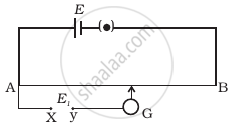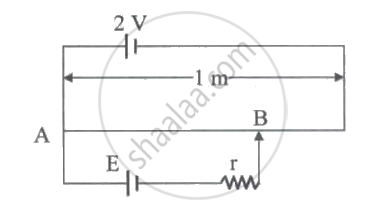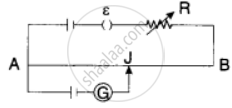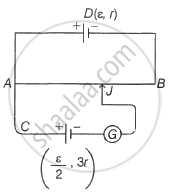Advertisements
Advertisements
प्रश्न
While doing an experiment with potentiometer (Figure) it was found that the deflection is one sided and (i) the deflection decreased while moving from one end A of the wire to the end B; (ii) the deflection increased. while the jockey was moved towards the end B.
- Which terminal + or – ve of the cell E1, is connected at X in case (i) and how is E1 related to E?
- Which terminal of the cell E1 is connected at X in case (ii)?

उत्तर
- If the current in auxiliary circuit (lower circuit containing primary cell) decreases, and potential difference across A and jockey/increases. Then deflection in galvanometer is one-sided and the deflection decreases while moving from one end ‘A ’ of the wire to the end ‘S’. And clearly, this is possible only when positive terminal of the cell E1 is connected at X and E1 > E.
- If the current in auxiliary circuit increases, and potential difference across A and jockey J increases. Then also deflection in galvanometer is one-sided. And this is possible only when negative terminal of the cell E1 is connected at X.
APPEARS IN
संबंधित प्रश्न
The net resistance of an ammeter should be small to ensure that _______________ .
How is potential gradient measured? Explain.
Describe how a potentiometer is used to compare the emf's of two cells by the combination method.
What is the SI unit of potential gradient?
In the given figure, battery E is balanced on 55 cm length of potentiometer wire but when a resistance of 10 `Omega` is connected in parallel with the battery, then it balances on 50 cm length of the potentiometer wire. The internal resistance r of the battery is ____________.

Potentiometer measures the potential difference more accurately than a voltmeter, because ______.
AB is a wire of potentiometer with the increase in the value of resistance R, the shift in the balance point J will be ______.

1°C rise in temperature is observed in a conductor by passing a certain current. If the current is double then the rise in temperature is approximately.
In potentiometer experiment, null point is obtained at a particular point for a cell on potentiometer wire x cm long. If the length of the potentiometer wire is increased without changing the cell, the balancing length will ______. (Driving source is not changed)
A potentiometer wire AB having length L and resistance 12r is joined to a cell D of emf ε and internal resistance r. A cell C having emt `ε/2` and internal resistance 3r is connected. The length AJ at which the galvanometer as shown in the figure shows no deflection is ______.

